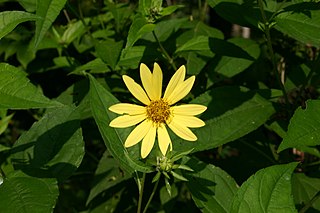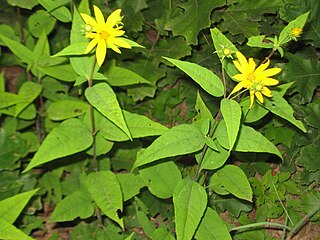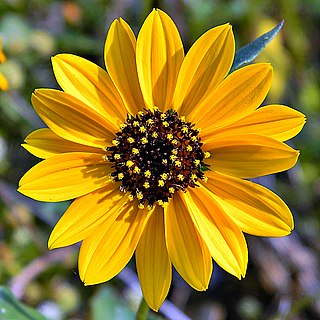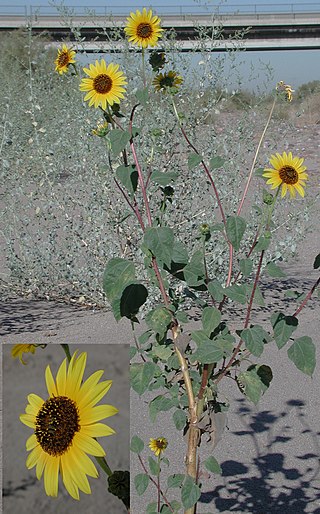
The common sunflower is a species of large annual forb of the daisy family Asteraceae. The common sunflower is harvested for its edible oily seeds, which are often eaten as a snack food. They are also used in the production of cooking oil, as food for livestock, as bird food, and as a plantings in domestic gardens for aesthetics. Wild plants are known for their multiple flower heads, whereas the domestic sunflower often possesses a single large flower head atop an unbranched stem.

Helianthus is a genus comprising around 70 species of annual and perennial flowering plants in the daisy family Asteraceae commonly known as sunflowers. Except for three South American species, the species of Helianthus are native to North America and Central America. The best-known species is the common sunflower. This and other species, notably Jerusalem artichoke, are cultivated in temperate regions and some tropical regions, as food crops for humans, cattle, and poultry, and as ornamental plants. The species H. annuus typically grows during the summer and into early fall, with the peak growth season being mid-summer.

Gaillardia pulchella is a North American species of short-lived perennial or annual flowering plants in the sunflower family.

Helianthus pauciflorus, called the stiff sunflower, is a North American plant species in the family Asteraceae. It is widespread across the Great Plains, the Rocky Mountains, and the Great Lakes region, and naturalized in scattered locations in the eastern United States and in much of southern Canada.

Helianthus × laetiflorus, the cheerful sunflower or perennial sunflower, is a plant in the family of Asteraceae. It is widespread in scattered locations across much of Canada from Newfoundland to British Columbia, and the central and eastern United States as far south as Texas and Georgia. This species is also commonly cultivated and may escape cultivation and be found in areas outside of its core range.

Helianthus maximiliani is a North American species of sunflower known by the common name Maximilian sunflower.

Helianthus divaricatus, commonly known as the rough sunflower, woodland sunflower, or rough woodland sunflower, is a North American species perennial herb in the family Asteraceae. It is native to central and eastern North America, from Ontario and Quebec in the north, south to Florida and Louisiana and west to Oklahoma and Iowa.

Helianthus grosseserratus, commonly known as sawtooth sunflower or thick-tooth sunflower, is a perennial sunflower in the family Asteraceae, with a large flowering head (inflorescence).

Helianthus occidentalis, the fewleaf sunflower or western sunflower, is a species of sunflower native to the Eastern and Central United States. It grows mostly in the Great Lakes Region and in the Ozarks, with additional populations scattered as far as Massachusetts, Texas, and the Florida Panhandle.

Helianthus petiolaris is a North American plant species in the family Asteraceae, commonly known as the prairie sunflower or lesser sunflower. Naturalist and botanist Thomas Nuttall was the first to describe the prairie sunflower in 1821. The word petiolaris in Latin means, “having a petiole”. The species originated in Western United States, but has since expanded east. The prairie sunflower is sometimes considered a weed.

Helianthus debilis is a species of sunflower known by the common names cucumberleaf sunflower, beach sunflower, weak sunflower, and East Coast dune sunflower. It is native to the United States, where it can be found along the Atlantic and Gulf Coasts. It is known elsewhere as an introduced species, such as South Africa, Australia, Taiwan, Slovakia, and Cuba.

Helianthus decapetalus, known by the common names thinleaf sunflower, thin-leaved sunflower, and woodland sunflower, is a perennial forb in the family Asteraceae. It is native to the Eastern and Central United States and Canada, from New Brunswick west to Iowa, Wisconsin, and Ontario, south as far as Georgia and Louisiana. It produces yellow composite flowers in late summer or early fall.

Bolboschoenus novae-angliae, common names New England bulrush, and Salt march bulrush is a plant species found along the Atlantic seacoast of the United States from Alabama to Maine. It grows in brackish and salt-water marshes and estuaries along the coast.

Helianthus anomalus, the western sunflower, is a species of plants in the family Asteraceae, found in the southwestern United States.

Helianthus eggertii, known as Eggert's sunflower, is a North American species of flowering plants in the family Asteraceae. It is native to Tennessee, Kentucky, South Carolina, and Alabama. It is best known as one of the few plants to have been delisted under the Endangered Species Act because of the species' recovery. It was described by John Kunkel Small in 1903.

Helianthus argophyllus is a North American species of sunflower known by the common name silverleaf sunflower. It is native to the coastal regions of the US state of Texas, and naturalized in other places.
Helianthus heterophyllus is a species of sunflower known by the common names variableleaf sunflower and wetland sunflower. It is native to the coastal plain of the southern United States from Texas to North Carolina.

Helianthus strumosus, the pale-leaf woodland sunflower, is a species of sunflower native to North America east of the Great Plains and is in the family Asteraceae. It is a native perennial sunflower that resembles other members of this family including the Pale Sunflower, Woodland Sunflower, Hispid Sunflower, and Jerusalem Artichoke. Pale-leaf sunflowers can be found in a diverse range of habitats including woodland areas, prairies, and meadows, providing that these habitats have access to partial sun.
Flaveria brownii, or Brown's yellowtops, is a North American plant species of Flaveria within the family Asteraceae. It is found only in the coastal regions of southern Texas in the United States. It grows primarily in sand dunes and salt marshes.

Helianthus devernii is a North American species of flowering plant in the daisy family Asteraceae, known by the common name Red Rock sunflower. The perennial herbaceous plant is endemic to a portion of Nevada's Red Rock Canyon National Conservation Area measuring less than 1 acre (4,000 m2), where it grows in just two desert spring locations within the Mojave Desert.


















